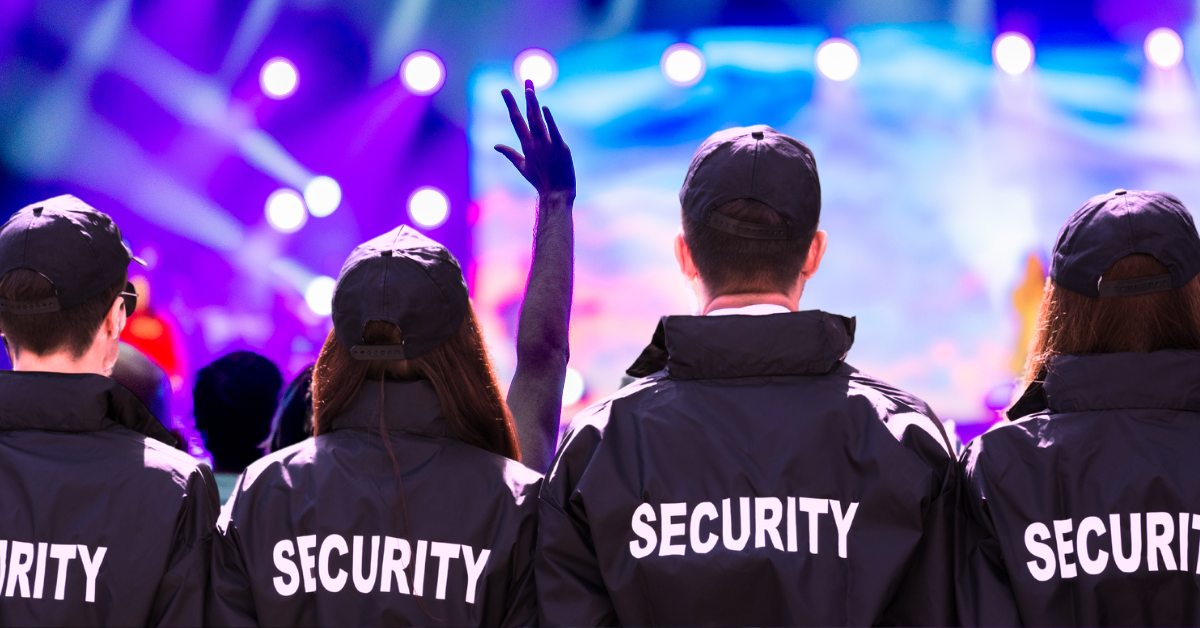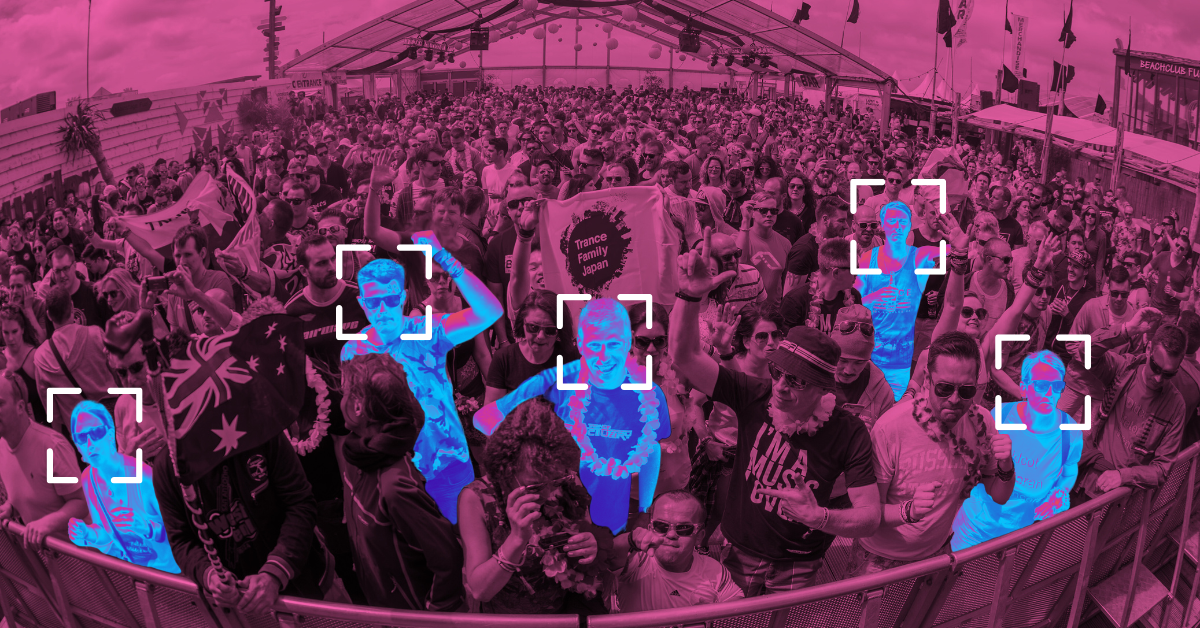Categories
Large events like concerts and sports games draw massive crowds, creating unique security challenges that facial recognition in security is helping to address. By quickly identifying individuals in real time, this technology enhances safety while streamlining access, but it’s not without hurdles.
This article explores how facial recognition for security works at events, real-world examples, why it’s necessary, its benefits, challenges like mask interference, global adoption trends, and future trends.

Facial recognition uses advanced algorithms to identify individuals by analyzing facial features from video feeds or images captured at event venues. Cameras scan attendees’ faces, generating a biometric template—a numerical representation of facial characteristics like the distance between eyes or jaw shape.
These templates are compared against databases of known threats or ticketed attendees, enabling rapid identification to prevent incidents or expedite entry. The process leverages deep neural networks, often running on server-class CPUs, with templates generated in as little as 0.1 seconds for fast, real-time security checks.
Facial recognition for security purposes is already in use at major events worldwide, proving its value in enhancing safety and efficiency.
Since 2018, Taylor Swift’s security team has used facial recognition in security at her concerts to screen attendees against a database of known stalkers—estimated at 3,000 individuals—ensuring the artist’s safety by identifying potential threats at entry points, as reported by the National Academies Press.
In 2023, the Met Police deployed facial recognition for security at a Premier League match between Arsenal and Tottenham, scanning fans to identify those with football banning orders, resulting in three arrests, as reported by The Standard. This marked the first use of such technology in the Premier League.
Facial recognition in security has become essential for managing the unique risks at large-scale events, where traditional methods often fall short in ensuring safety and efficiency.
Massive Crowds Overwhelm Manual Checks: With tens of thousands of attendees, manual identity checks are impractical, requiring automated facial recognition in security to swiftly identify threats like known violent offenders or ticket scalpers.
High-Profile Events Attract Crime: Events like concerts are prime targets for crime, as seen in the 2015 Hajj pilgrimage crowd crush in Mecca, which killed thousands, emphasizing the need for better crowd management tools to prevent such tragedies.
Global Terrorism Threats: The rise in terrorism risks, such as potential attacks at concerts, necessitates proactive screening for known threats, a capability facial recognition for security provides, as discussed in its use at U.S. sporting events.
Faster Entry for Better
Experiences: Facial recognition within security speeds up entry by reducing bottlenecks, cutting wait times compared to manual checks, enhancing the attendee experience while maintaining robust safety measures.

Facial recognition offers a range of advantages that make it indispensable for event management. It enhances safety by instantly identifying individuals on blacklists, such as those with a history of violence, preventing them from entering venues like stadiums, as seen in European football matches where such systems have reduced hooliganism.
It also speeds up entry processes, with automated gates cutting wait times by up to 30% compared to manual checks, improving the overall experience for attendees. Additionally, the technology provides law enforcement with real-time intelligence, allowing them to focus resources on potential threats during large gatherings, ensuring both safety and efficiency.
Facial recognition at events faces several obstacles that can impact its effectiveness.
Masks, widely used since the COVID-19 pandemic, hinder facial recognition, with failure rates as high as 50% when faces are partially covered, as noted in a 2020 post by the Tor Project on X, highlighting the need for alternative methods like periocular recognition.
Poor lighting or camera placement, such as facing a window, can lead to underexposed images, reducing accuracy, with some systems requiring supplemental illumination for nighttime events.
Algorithms can exhibit bias, with higher false positives for certain demographics, such as women and people of color, potentially leading to unfair exclusions or misidentifications at events.
Privacy concerns lead to pushback, with attendees often unaware their biometric data is being collected, raising ethical questions about consent and surveillance at public gatherings.
The adoption of facial recognition for security at events is expanding worldwide, driven by the need for enhanced safety, though progress varies due to regional regulations and public backlash. In the U.S., 70% of major sports venues had adopted facial recognition by 2024 for entry screening, reflecting a post-COVID push for contactless security measures.
In Asia, Japan deployed facial recognition technology at the 2021 Tokyo Olympics to monitor athletes and attendees, reducing unauthorized access by 25%, though privacy concerns lingered among attendees.
In Europe, adoption has been slower due to GDPR compliance; for instance, Manchester City and Newcastle United faced significant pushback when considering facial recognition at their stadiums, with privacy groups and authorities ruling its use ‘disproportionate’ under GDPR Article 9(2), as reported in 2023 by Comparitech. As a result, only a limited number of large venues in Europe have implemented the technology by 2025, balancing security needs with stringent data protection laws, highlighting the diverse global landscape.
As facial recognition technology evolves, its applications at events are set to expand, offering innovative ways to enhance safety, streamline operations, and improve attendee experiences.
In the near future, facial recognition for security could enable ticket purchases at events, where fans register their facial ID with ticketing platforms, allowing them to buy and validate tickets instantly at the venue by scanning their face, reducing fraud and scalping.
Facial recognition might be used to offer tailored experiences, such as recognizing VIP attendees at concerts and directing them to exclusive areas or sending personalized welcome messages on stadium screens, enhancing engagement while ensuring secure access.
Advanced systems could analyze facial expressions or crowd behavior to detect potential disturbances, like aggressive actions at sports events, alerting security teams in real time to prevent escalations and ensure a safer environment.
Facial recognition could sync with wearable devices, like smart wristbands at festivals, to authenticate attendees for cashless payments or access to restricted zones, combining security with convenience in a seamless event experience.
Facial recognition in security is revolutionizing event safety in 2025, offering speed and precision in identifying threats, as seen at Taylor Swift concerts and Premier League matches. However, challenges like masks, bias, and privacy concerns must be addressed to ensure equitable and ethical use. As technology evolves, balancing security with individual rights will be key to its widespread acceptance in the West, making events safer and more enjoyable for everyone.